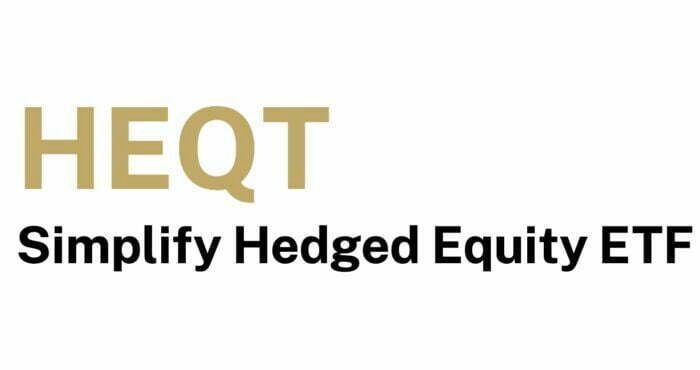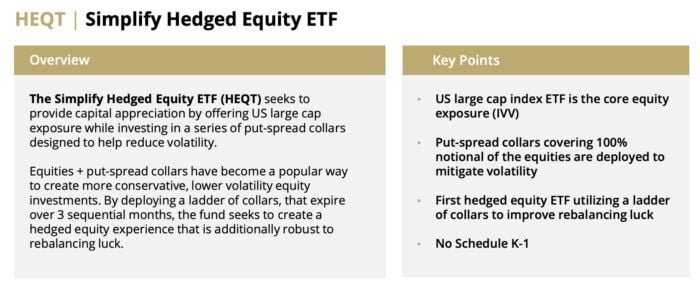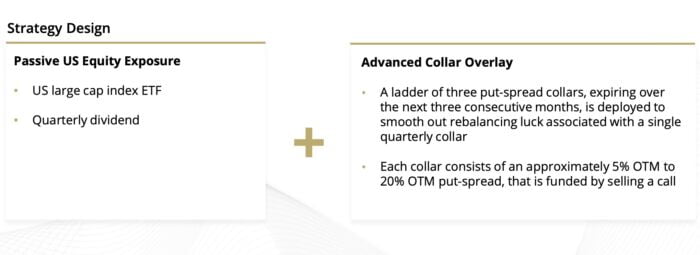Last year was a brutal reminder that a non-diversified 60/40 portfolio isn’t prepared for every economic regime under the sun.
What happens when the “fixed income” sleeve of your portfolio doesn’t defend when markets are getting pulverized?
In this type of scenario you’re grasping for straws with both stocks and bonds down at the same time.
One potential solution that you can add to this classic mix of long stocks/bonds is a “hedged equity” strategy.

Thus, I’m thrilled to welcome Larry Kim from Simplify ETFs to discuss the strategy behind HEQT ETF.
Also known as Simplify Hedged Equity ETF.
Without further ado, let’s turn things over to Larry!

Reviewing The Strategy Behind HEQT ETF (Simplify Hedged Equity ETF)
Hey guys! Here is the part where I mention I’m a travel content creator! This “The Strategy Behind The Fund” interview is entirely for entertainment purposes only. There could be considerable errors in the data I gathered. This is not financial advice. Do your own due diligence and research. Consult with a financial advisor.

These asset allocation ideas and model portfolios presented herein are purely for entertainment purposes only. This is NOT investment advice. These models are hypothetical and are intended to provide general information about potential ways to organize a portfolio based on theoretical scenarios and assumptions. They do not take into account the investment objectives, financial situation/goals, risk tolerance and/or specific needs of any particular individual.

What’s The Strategy Of HEQT ETF?
For those who aren’t necessarily familiar with a “hedged-equity” strategy, let’s first define what it is and then explain this strategy in practice by giving some clear examples.
The Simplify Hedged Equity ETF (HEQT) seeks to provide capital appreciation by offering US large cap exposure while investing in a series of put-spread collars designed to help reduce volatility.
A hedged equity exposure can serve multiple investor types and investment goals, including:
- Reducing portfolio risk without adding any fixed income exposure
- As a way to increase equity exposure for investors that are overly-conservative
- As a “risk-off” alternative for tactical investors who don’t wish to be totally out of equities
source: Simplify Asset Management on YouTube
Unique Features Of Simplify Hedged Equity Fund HEQT ETF
Let’s go over all the unique features your fund offers so investors can better understand it. What key exposure does it offer? Is it static or dynamic in nature? Is it active or passive? Is it leveraged or not? Is it a rules-based strategy or does it involve some discretionary inputs? How about its fee structure?
The fund begins with full exposure to large cap US equities via ownership of a low cost large cap US equity ETF. The full notional value of the equities is then hedged with 3 month put-spread collars.
Here’s how the collars work:
– Step 1 is to buy 3 month equity put options approximately 5% out-of-the-money. This is the hedging vehicle that will gain in value should stocks decline.
– Step 2 is to sell 3 month equity put options approximately 20% out-of-the-money. This step is designed to partially finance the purchase of the 5% OTM option.
– Step 3 is to sell 3 month out-of-the-money equity call options to complete the financing.
– The net result of Steps 1-3 is zero cost to the fund, as the premiums collected = the premiums paid.
While the net cash cost of the options overlay is zero, the strategy does come with an economic cost. That is, any increase in value of the equities will be capped at the strike price of the equity call options. The cap will vary with market conditions. Historically, the cap has averaged somewhere between 3-5% over a rolling 3 month time period.
One final wrinkle is that instead of a single 3 month put-spread collar, the fund will diversify into three put-spread collars, each spaced one month apart. This is designed to minimize the effects of path dependency (timing luck) on the fund’s returns.
While not technically an index fund, the fund’s process is systematic and rules-based.
As for the question regarding leverage, the answer is somewhat nuanced. The fund is not leveraged in the sense that it is not designed to multiply the underlying asset returns. However, options themselves could be considered a form of leverage, since a small number of contracts can represent a much larger notional exposure.
The fund’s expense ratio is 0.53%.

What Sets HEQT ETF Apart From Other Hedged Equity Funds?
How does your fund set itself apart from other “hedged equity” funds being offered in what is already a crowded marketplace? What makes it unique?
There are a few products running the costless put-spread collar strategy, but HEQT sets itself apart by being the only product with a diversified set of three collars spaced monthly. Reducing the effects of timing luck can have a significant effect on returns.
This research paper explains this phenomenon in detail:
https://papers.ssrn.com/sol3/papers.cfm?abstract_id=4336419

What Else Was Considered For HEQT ETF?
What’s something that you carefully considered adding to your fund that ultimately didn’t make it past the chopping board? What made you decide not to include it?
The put-spread collar strategy can be expressed in nearly limitless ways. For example, the strategy could be run with different underlying assets: Nasdaq 100, Emerging Market Equities, Small Caps, etc. It could also be run with different exposures. For example, with different amounts of leverage and different amounts of downside protection. Ultimately, we made the decision to start by launching the most common exposure: large cap US equities with 5% out-of-the-money put options. It’s certainly possible that different variations of the strategy will be launched in the future.

When Will HEQT ETF Perform At Its Best/Worst?
Let’s explore when your fund/strategy has performed at its best and worst historically or theoretically in backtests. What types of market conditions or other scenarios are most favorable for this particular strategy? On the other hand, when can investors expect this strategy to potentially struggle?
The fund will underperform unhedged equities during bull markets and outperform during bear markets. From a risk-return perspective, the strategy can be considered similar to the 60/40 stock/bond portfolio.

Why Should Investors Consider Simplify Hedged Equity Fund HEQT ETF?
If we’re assuming that an industry standard portfolio for most investors is one aligned towards low cost beta exposure to global equities and bonds, why should investors consider your fund/strategy?
Not all investors can handle the volatility of un-hedged equities. A hedged equity product might be the option that keeps them invested during times of extreme volatility.
Other investors who have a negative view on fixed-income might prefer to own HEQT as an alternative to the 60/40 portfolio.
Finally, traders who follow tactical strategies can consider using HEQT as their “risk-off” allocation when their signals call for it. This has the advantage of reducing risk while at the same time maintaining exposure to equities so they don’t get caught wrong-footed should the market move against them.


How Does HEQT ETF Fit Into A Portfolio At Large?
Let’s examine how your fund/strategy integrates into a portfolio at large. Is it meant to be a total portfolio solution, core holding or satellite diversifier? What are some best case usage scenarios ranging from high to low conviction allocations?
HEQT could serve in all three scenarios. It could be a single-ticker portfolio solution for small accounts, a core holding in a diversified portfolio or as a satellite diversifier.
One common way to integrate HEQT is to take an equal amount from equities and fixed income. For example, if the portfolio started as 60% equities and 40% bonds, the new portfolio could be 50% equities, 30% bonds and 20% HEQT.

The Cons of HEQT ETF
What’s the biggest point of constructive criticism you’ve received about your fund since it has launched?
Some clients have expressed a wish for differing levels of protection. For example, with 10% OTM put options instead of 5%.
source: Simplify Asset Management on YouTube

The Pros of HEQT ETF
On the other hand, what have others praised about your fund?
While a costless put-spread collar strategy sounds complicated, clients have appreciated the fact that such a strategy can be simple to implement in ETF form.
source: Simplify Asset Management on YouTube

Learn More About HEQT ETF
We’ll finish things off with an open-ended question. Is there anything that we haven’t covered yet that you’d like to mention about your fund/strategy? If not, what are some other current projects that you’re working on that investors can follow in the coming weeks/months?
At Simplify we often say that you should “diversify your diversifiers”. Most traditional portfolios attempt to add downside protection by diversifying into fixed-income. However, as we saw in 2022, there is no guarantee that stocks and bonds will be negatively correlated. Adding an additional source of diversification with downside hedges could have improved portfolio results.

Connect With Simplify ETFs
Twitter: @SimplifyAsstMgt
YouTube: Simplify Asset Management
Simplify Asset Management: Simplify ETFs
Fund Page: HEQT ETF
Nomadic Samuel Final Thoughts
I want to personally thank Larry Kim at Simplify for taking the time to participate in “The Strategy Behind The Fund” series by contributing thoughtful answers to all of the questions!
If you’ve read this article and would like to have your fund featured, feel free to reach out to nomadicsamuel at gmail dot com.
That’s all I’ve got!
Ciao for now!
Important Information
Investment Disclaimer: The content provided here is for informational purposes only and does not constitute financial, investment, tax or professional advice. Investments carry risks and are not guaranteed; errors in data may occur. Past performance, including backtest results, does not guarantee future outcomes. Please note that indexes are benchmarks and not directly investable. All examples are purely hypothetical. Do your own due diligence. You should conduct your own research and consult a professional advisor before making investment decisions.
“Picture Perfect Portfolios” does not endorse or guarantee the accuracy of the information in this post and is not responsible for any financial losses or damages incurred from relying on this information. Investing involves the risk of loss and is not suitable for all investors. When it comes to capital efficiency, using leverage (or leveraged products) in investing amplifies both potential gains and losses, making it possible to lose more than your initial investment. It involves higher risk and costs, including possible margin calls and interest expenses, which can adversely affect your financial condition. The views and opinions expressed in this post are solely those of the author and do not necessarily reflect the official policy or position of anyone else. You can read my complete disclaimer here.






